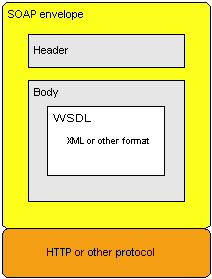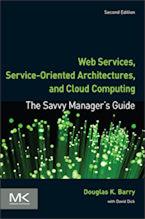SOAP
SOAP provides the envelope for sending Web Services messages over the Internet/Internet. It is part of the set of standards specified by the W3C. SOAP is an alternative to Representational State Transfer (REST) and JavaScript Object Notation (JSON).

The SOAP envelope contains two parts:
- An optional header providing information on authentication, encoding of data, or how a recipient of a SOAP message should process the message.
- The body that contains the message. These messages can be defined using the WSDL specification.
SOAP commonly uses HTTP, but other protocols such as Simple Mail Transfer Protocol (SMTP) may by used. SOAP can be used to exchange complete documents or to call a remote procedure.
NOTE: SOAP at one time stood for Simple Object Access Protocol. Starting with SOAP Version 1.2, the letters in the acronym have no particular meaning.
Also see how SOAP is used in the ebXML Message Service Specification (MSS).
Organization: W3C
More information: SOAP page on the W3C website
SOAP and Web Services
The following figure illustrates using SOAP for Web Services. Also see Web Services Explained.

Context for SOAP
Related Articles for SOAP
- Asynchronous Application Service Protocol (ASAP) for SOAP
- Message Service Specification (MSS)
- JavaScript Object Notation (JSON)
- Representational State Transfer (REST)
- RosettaNet Business Message
- Web Distributed Data Exchange (WDDX)
- Web Services Addressing (WS-Addressing)
- Web Services Eventing (WS-Eventing)
- Web Services Notification (WSN)
- Web Services Reliability (WS-Reliability)
- Web Services Reliable Messaging (WS-ReliableMessaging)
- XML Protocol (XMLP)
Author
Douglas K Barry
Principal
You may use this material for your work or classes. Reprint Policy. Be sure to check the menu at the left for other articles available on this site.
The Savvy Manager's Guide
Douglas K Barry is also the author of a book that explains Web Services, service-oriented architecture, and Cloud Computing in an easy-to-understand, non-technical manner.
Web Services, Service-Oriented Architectures, and Cloud Computing: The Savvy Manager's Guide (Second Edition)
by Douglas K Barry with David Dick
This is a guide for the savvy manager who wants to capitalize on the wave of change that is occurring with Web Services, service-oriented architecture, and—more recently—Cloud Computing. The changes wrought by these technologies will require both a basic grasp of the technologies and an effective way to deal with how these changes will affect the people who build and use the systems in our organizations. This book covers both issues. Managers at all levels of all organizations must be aware of both the changes that we are now seeing and ways to deal with issues created by those changes.

